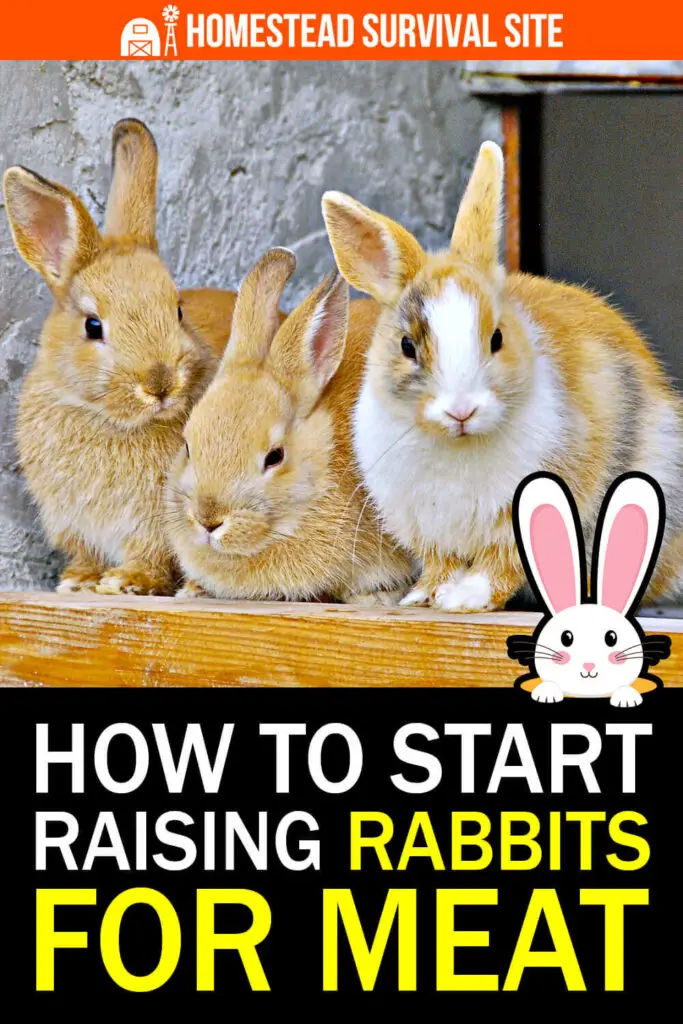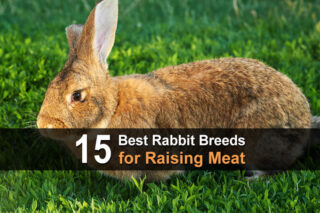Estimated reading time: 12 minutes
For many people making their first foray into livestock, chickens are the first choice. But there’s another livestock animal that requires about the same amount of maintenance and equipment that provides meat on a par with chicken: rabbits. The only downside is they don’t lay eggs.
And if you’re already raising chickens, rabbits are a great next step for your early homesteading efforts. Raising rabbits for meat doesn’t require a lot of space and can be done on a homestead and even in a backyard. The rabbit hutches are relatively small in size and they are very quiet animals compared to the pre-dawn crowing of a rooster.
The best way to start is with 3 does (female rabbits) and one buck (male rabbits). There are 14 rabbit breeds often recommended for raising rabbits for meat. Start with a more basic breed like New Zealands and as you gain experience you can move up to some of the larger heritage breeds.
Here’s a link to a good article on rabbit breeds for meat.
Want to save this post for later? Click Here to Pin It On Pinterest!
Getting Started
Before you build a hutch and stock it with rabbits it would be wise to do some homework. There are many books about raising rabbits but this one is focused on raising rabbits as a meat source:
Take some time to at least read this book or other books on raising rabbits, and keep it handy if you run into any unforeseen problems down the road. It also helps if you have a local friend or neighbor with some experience with raising rabbits.
You could also go back for advice with the person who sells you your first bunch of rabbits. Most times people who raise and sell livestock will be happy to offer some tips and advice.
Finally, have a plan. Apply the research you’ve done whether from books or the Internet to at least make a to-do list. We’ll offer some thoughts and ideas in a checklist in a moment, but everyone’s situation varies.
Build Your Hutch
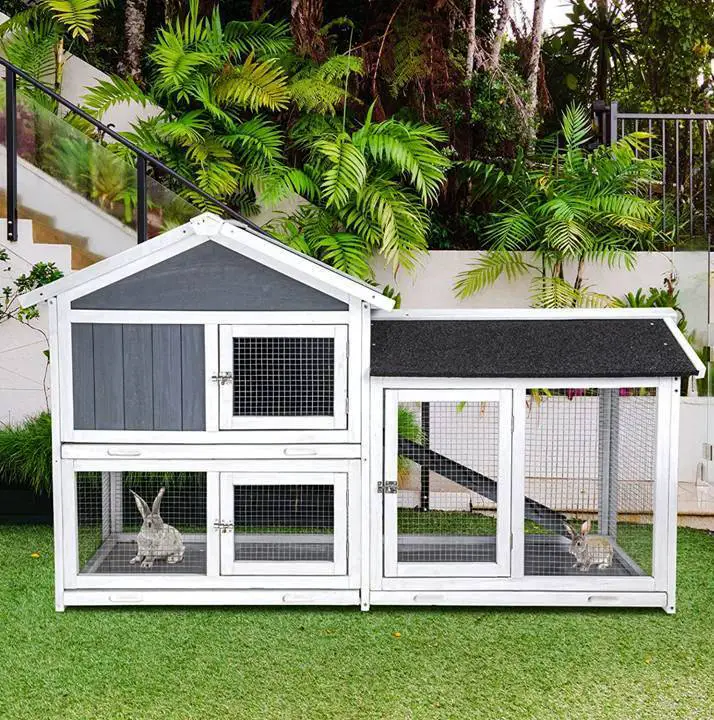
You can always buy a hutch and they’re not terribly expensive, but if you’re handy with tools and some carpentry skills you can build your own. Here’s a link to a YouTube video about how to build a hutch.
There are also articles with blueprints and shopping lists for building your own hutch. What’s good about building your own is that you can always add on if decide to expand the size of your herd. And yes, a group of rabbits raised for meat are called a herd although other names include a warren, a nest and even a “fluffle.” We’re going to stick with herd.
Hutch Location
Another thing to think about is the location of your hutch. You don’t want it in direct sunlight all day although some amount of sunlight will give your rabbits a dose of Vitamin-D.
You obviously wouldn’t build it in a spot known for pooling or standing water, and think about how winter winds might affect your rabbits. Many people build their hutch attached to the side of a barn or shed, or even next to the chicken coop to make overall animal maintenance easier.
The size of your hutch depends on the size of your herd. For a starter herd of 4 rabbits (3 does and a buck). The cage for your hutch doesn’t need to more than 2 to 3 feet square. Here’s a link to an excellent article that connects you to free plans for 8 different rabbit hutch designs.
As you consider the design of your hutch you’ll notice they have a similar concept as a chicken coop with a caged living area, and access to a “run” where they can roam and feed.
Assemble Your Equipment
In addition to the hutch there’s some basic equipment you’ll need to raise your rabbits. You can improvise many of these items but some of the commercially designed products are somewhat maintenance free and multipurpose. They include:
- On demand, suction water bottles
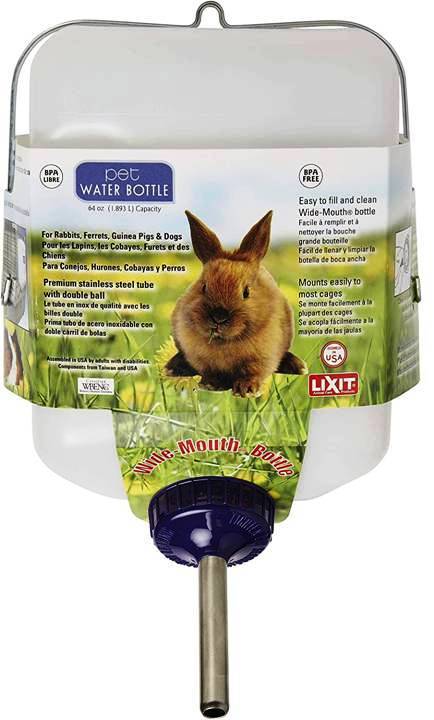
These allow a rabbit to draw water without waste or spillage. They’re known for knocking over bowls of water and food. It also helps you maintain a constant supply of water over time.
- Pellet feeders and hay holder

These helps to somewhat manage the amount of feed available to the rabbits without scattering or waste. Hay is an important part of a rabbit’s diet (especially in winter when greens are not growing) and a holder keeps the hay clean and uncontaminated by rabbit droppings.
- Rest Pads
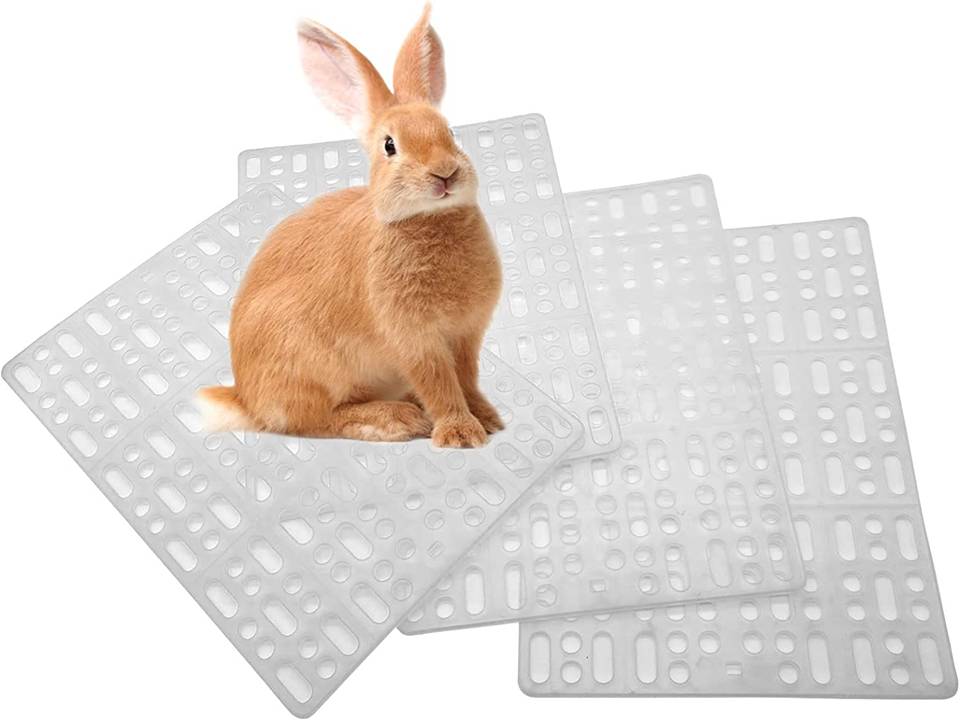
Some rabbit species have very soft pads on their feet and a rest pad gives them a break from the hard surfaces or wire floors of a hutch.

Rabbits instinctively live in the comfort and security of in-ground burrows. A nesting box gives them the reassurance of a safe and enclosed space.
- Rabbit bedding
There are commercial rabbit bedding products but a layer of cut straw works just as well. It’s not necessary but the hollow straw provides a layer of insulation in winter to help keep them warm.
- Chew sticks. Rabbit teeth never stop growing. If you don’t give them something to chew on they’ll start gnawing on the wood frame of the hutch. You could also give them sticks from trees if you need to improvise.
- Cleaning supplies. A small broom; small rake and 5-gallon bucket for soiled hay and manure.
Free Roaming?
There are free-range chickens and yes, free roaming rabbits. Much like chickens, rabbits can be allowed to free range. This would require a well fenced yard or area because if they can escape, they will.
The benefit of free roaming rabbits is that it will give them the room to exercise and access to a variety of plants and vegetables. You could even selectively plant certain plants and vegetables to add to their diet. Just make sure you don’t let them roam into your regular vegetable garden.
The good news is that free roaming can save you some money and effort with rabbit feed. The downside is that you may not be able to keep track of what or how much to feed your rabbits if you don’t know how much they’ve had each day while roaming around.
Free roaming also exposes them to predators depending on the local wildlife.
Typically they’ll return to the hutch at night or when tired, and if it’s the only source of water that will be an incentive. Here’s a link to a video with more information about free roaming rabbits.
Figure Out Your Feeding Options
Rabbits seem to do just fine in nature eating a variety of plants. (Just ask any gardener). But if you want to boost the meat output and keep your rabbits as healthy as possible it helps to feed them commercially sold rabbit pellets. They’re fortified with vitamins and minerals to keep your rabbits growing and healthy.
However, supplementing commercial pellets with plants and vegetables from your yard and garden is another healthy option. In a time when you might not be able to buy rabbit feed this may be your only option.
Kitchen vegetable scraps that usually go in the compost heap are one option. The same is true for any discounted vegetables you see at the grocery store. Any excess or particularly gnarly vegetables from your garden could also be on the menu.
But it’s not just about vegetables. Wild plants like dandelion, clover, plantain and other edible wild plants you might forage will make the fussiest rabbit happy.
And then there’s hay. In winter you might not have as many vegetables and wild plants on hand. Hay easily keeps over winter and the rabbits will eat it. It’s best to support the hay in the holder we previously mentioned. This may be their only source of fiber in winter, so don’t skip the hay.
Care and Feeding Tips
What and how much you feed your rabbits everyday is going to vary. It depends on the size of your rabbits, the breed and their age. Here’s a link to an article that identifies the quantities and range of foods to keep your rabbits healthy and growing.
Feed your rabbits more grain and pellets in winter. The calories from fat will help them generate body heat and keep them strong.
Rabbits like a layer of bedding on the bottom of the hutch. Unfortunately, this can prevent any droppings from falling through the wire mesh bottom but they’ll be much happier with a layer of bedding. It’s not necessary and many people skip it but you should use it in winter.
Waste management is another important step to keep your rabbits healthy.
Many hutch designs have a wire mesh floor that allows the rabbit pellets or waste to fall through the wire to the dirt floor below. (Assuming you don’t have a layer of bedding). Some hutch designs have a wooden tray at the bottom that can slide out to make cleaning easier.
Rabbit manure is excellent for your compost heap, although like all manures it should be composted for up to a year before incorporating it into the garden. Some argue that rabbit manure can be used sooner but that’s up to you.
Hutch cleaning should be a daily chore to remove any manure, but you can get away with cleaning out the entire hutch only once or twice a week. The good news is that rabbits tend to be clean creatures and will go in the same spot consistently so manure cleanup is easier.
When cleaning the whole hutch you want to clean out the old bedding and any tossed hay and replace the bedding.
Rabbit Breeding Advice
The engine that drives success with raising rabbits is their ability to reproduce. The common mythology is that they are very good at it, but there are a few things you should keep in mind to help manage the process. Here are some key steps to remember:
- A doe should reach adult size and weight before allowing her to breed. Smaller breeds will reach maturity around five months and larger breeds around nine months.
- House your doe near the buck’s quarters. When she goes into heat (signs include thumping her feet and grunting) she will be ready to breed and can be placed in with the buck.
- She can be housed with him until she nears her full term of pregnancy, at which point she should be moved into her own quarters where her nest box is ready and waiting.
- The does commonly birth 5 to 8 litters per year consisting of 2 to 4 pups.
Here’s a link to a very good article that covers some of the nuances of rabbit breeding in more detail: A Complete Guide to Breeding Rabbits for Beginners.
Disease, Illnesses and Predators to Watch Out For
Similar to all livestock, rabbits are susceptible to a range of illnesses and disease. They’re also a prime target for a variety of predators from dogs to coyotes, wolves, hawks and eagles.
Free roaming rabbits are most commonly preyed upon by hawks, owls and eagles, although coyotes can be a problem if the fencing is not secure and then there’s always the family dog.
Just as problematic are the various diseases affecting rabbits. The easiest way to prevent any disease is to make sure their hutch is clean. In spite of your best efforts however, disease is always a possibility. Here’s a link to the 5 most common diseases affecting rabbits. There’s also a great book about home veterinary care including rabbits.
When to Cull the Herd
The average lifespan of a rabbit varies from 8 to 12 years depending on breed and overall health. But you don’t want to wait that long to cull and butcher your rabbits.
Most rabbits raised for meat are butchered at 3 months of age. These are referred to as “fryers” and typically weigh 1.5 to 3.5 pounds. A smaller percentage are butchered at 8 months of age and weigh about 4 pounds on average. These are referred to as “roasters” because the meat is tougher and require slow roasting to tenderize.
Butchering Rabbits
If you’re squeamish about killing and butchering your rabbits you probably shouldn’t raise them. In that case you’ll have to buy your own rabbit meat if you want rabbit on the menu.
Here’s a link to a YouTube video that demonstrates the whole process. There are also articles on the subject.
Storing your meat is no different than any other meats in your refrigerator or freezer. Vacuum sealing them in sealed, plastic bags is a good idea when freezing.
Rabbit Recipes
On a fundamental level, cooking rabbit is very similar to the recipes and techniques you would use for cooking chicken. Rabbit meat can be fried, baked, roasted, stewed and use as an ingredient in soups or even dried to make a rabbit jerky.
Here are some excellent books and links to articles and videos on the various ways you can prepare rabbit. In many parts of the world, rabbit is considered high-class cuisine. Some of these recipes reflect that.
- Southern Fried Rabbit
- Rabbit Cacciatore
- Rabbit Recipes
- More Rabbit Recipes
- Rabbit in Wine Sauce
- Rabbit Stew (YouTube)
- How to Cook Rabbit on the Grill (YouTube)
- Roasted Rabbit (YouTube)
- Canning Rabbit (You Tube)
Be Ready to Expand
Given the fact that rabbits reproduce prodigiously (16 to 32 pups per year from one doe), you are either going to need to expand your hutch and your rabbit run, or get used to eating rabbit every day. That might be a good argument for thinking ahead to a free roaming setup with a good fence. You’ll also need to expand the size of your hutch.
The good news if your expanding your rabbit raising is that it’s obviously working. As time goes on and as you explore more recipes you’ll find that rabbit may be replacing many of the other meats that cost so much these days.
Better yet, you’ll have plenty of rabbit meat to spare with family, friends and neighbors. One word of advice if they’re new to eating rabbit -bring the first few rabbits over already cooked. Once they taste it they’ll be more amenable to your raw rabbit donations in the future.
Southern Fried Rabbit
Equipment
- 1 12-inch cast iron skillet
- 2 rimmed baking sheets
- 2 wire cooling racks
Ingredients
- 3 cups buttermilk
- 2 tsps Kosher salt
- 1/2 tsp Mustard powder
- 1/2 tsp Paprika
- 1/4 tsp garlic powder
- 1/4 tsp Onion powder
- 8 sprigs fresh thyme
- 2 sprigs fresh rosemary
- 1 3 lb rabbut broken down into 2 front legs, 2 hind quarters and 1 saddle cut in half crosswise
Dredge and Fry
- 2 cups flour
- 1 tbsp Kosher salt
- 1/2 tsp ground black pepper
- 4 cups vegetable oil or other neutral oil
Instructions
- To Brine the Rabbit: In a large bowl, whisk together buttermilk, salt, mustard powder, paprika, black pepper, garlic powder, onion powder, rosemary, and thyme. Add rabbit pieces and toss to thoroughly coat. Transfer contents of bowl to a 1-gallon zipper-lock freezer bag and refrigerate for at least 8 hours and up to 12 hours, flipping bag occasionally to redistribute the contents and coat rabbit evenly.
- To Dredge and Fry: Adjust oven rack to middle position and preheat oven to 200°F (95°C). Set a wire rack in a rimmed baking sheet. In a large bowl, whisk together flour, salt, and pepper. Working with one piece of rabbit at a time, remove rabbit from marinade, allowing excess buttermilk to drip off, and add to flour mixture. Toss to thoroughly coat, pressing with your hands to get flour to adhere to rabbit in an even layer. Transfer to prepared wire rack, and repeat dredging process with remaining rabbit pieces. Let dredged rabbit rest for 15 minutes.
- Meanwhile, line a second rimmed baking sheet with paper towels and set a clean wire rack in it. Heat oil in a 12-inch cast iron skillet or 14-inch wok over medium-high heat to350°F (175°C). Carefully add half the rabbit pieces and fry, adjusting heat to return to a 350°F (175°C) frying temperature, until golden brown on the first side, about 8-10 minutes. Using tongs, carefully flip rabbit pieces, and continue to fry until golden brown all over, and thickest part of rabbit registers 160°F (70°C) on an instant-read thermometer, about 7 minutes longer. Transfer fried rabbit to prepared wire rack, season lightly with salt, then transfer to oven to keep warm.
- Skim any browned bits from oil and discard. Return oil to 350°F (175°C), and repeat with remaining rabbit. Let rest 5 minutes. Serve.
Make-Ahead and Storage
- The fried rabbit is best enjoyed immediately afterfrying. Placed in an airtight container, the rabbit will keep in therefrigerator for up to five days. To reheat, place chicken on a wire rack setin a rimmed baking sheet in a preheated 350°F (175°C) oven; alternatively, youcan refry it.
You May Also Like:



